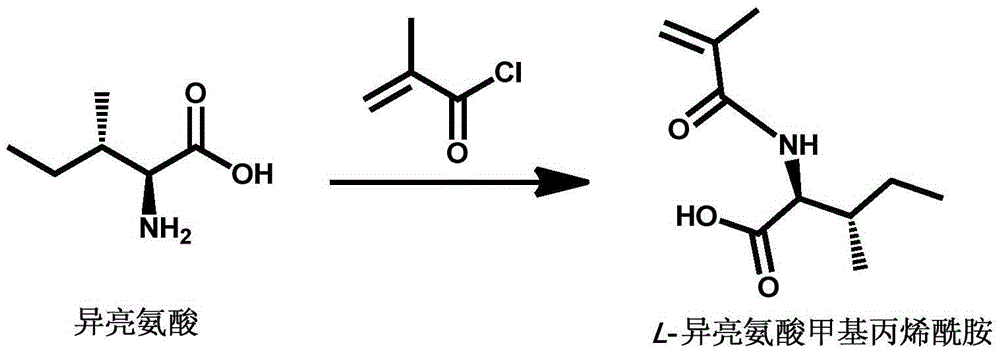Fluorescent star polymer, preparation method and applications thereof
A star-shaped polymer, fluorescent technology, applied in the fields of botanical equipment and methods, applications, animal repellants, etc., can solve the problem of not being able to be used as a general-purpose protein molecular carrier, achieve excellent biocompatibility, expand insecticidal spectrum effect
- Summary
- Abstract
- Description
- Claims
- Application Information
AI Technical Summary
Problems solved by technology
Method used
Image
Examples
Embodiment 1
[0057] Example 1 takes the star-shaped poly-L-isoleucine methacrylamide as an example to illustrate the preparation method of the fluorescent star-shaped polymer of the present invention.
[0058] (1) Synthesis of monomers: as attached figure 1 As indicated, L-isoleucine (1.0 g, 7.5 mmol) was dissolved in aqueous sodium hydroxide solution (1 mol / L, 7.5 mL) and stirred evenly. At 0°C, methacryloyl chloride (1.17 g, 11.2 mmol) was added dropwise, and the pH value was adjusted with a 2 mol / L aqueous sodium hydroxide solution during the 30-minute addition to keep it near 10. When returning to room temperature (25° C.) to start the reaction, the pH value was maintained around 7.5. After 1 hour, it was acidified with aqueous hydrochloric acid (2 mol / L) and extracted with ethyl acetate (4 x 30 mL). After the organic phase was dried over anhydrous sodium sulfate, most of the solvent was removed by a rotary evaporator, and then the product was obtained by recrystallization to finally...
experiment example 1
[0061] Optical properties of experimental example 1 poly-L-isoleucine methacrylamide
[0062] Dissolve 1.2 mg of poly-L-isoleucine methacrylamide (P1) in 8 mL of pure water to make a concentration of 1.25×10 -5 mol / L aqueous solution, respectively diluted to a concentration of 6.25×10 -6 mol / L, 4.16×10 -6 mol / L, 2.76×10 -6 mol / L and 1.84×10 -6 mol / L aqueous solution, and test their UV absorption and fluorescence emission spectra respectively, see attached Figure 5 .
[0063] In order to observe the effect of protein on the fluorescence properties of P1, the concentration was 5.00×10 -5 20 μL of mol / L Histone (HS) aqueous solution was added dropwise to a concentration of 1.84×10 -6 mol / L P1 aqueous solution, that is, add one part of HS to P1 aqueous solution, test and record its fluorescence spectrum, and add a total of 8 parts of HS in the same way, and compare the obtained fluorescence spectra in the appendix Figure 6 . Experimental example 2 Carrying foreign protei...
experiment example 2
[0064] The synthesized amino star-shaped polymer carrier molecules and exogenous basic protein molecules form carrier / protein molecule complexes, and are incubated with living cultured cells. The effect of the charge ratio (N / P) on the cell transfection of the charge amount to the cation carried by the protein molecule. as attached Figure 7 As shown, by studying the results of transfected cells with carrier molecules and protein molecular complexes formed at different N / P ratios (4:1, 2:1, 1:1; 2:1, 4:1), it was found that carrier molecules Good loading capacity was shown at all N / P ratio conditions. When cells were incubated with a 4:1 N / P synthetic carrier / protein molecule complex, exogenous protein molecule signals could be detected in the cells at 0.5 h, indicating that carrier molecules can quickly and efficiently carry exogenous protein molecules into living cells.
PUM
 Login to View More
Login to View More Abstract
Description
Claims
Application Information
 Login to View More
Login to View More - R&D
- Intellectual Property
- Life Sciences
- Materials
- Tech Scout
- Unparalleled Data Quality
- Higher Quality Content
- 60% Fewer Hallucinations
Browse by: Latest US Patents, China's latest patents, Technical Efficacy Thesaurus, Application Domain, Technology Topic, Popular Technical Reports.
© 2025 PatSnap. All rights reserved.Legal|Privacy policy|Modern Slavery Act Transparency Statement|Sitemap|About US| Contact US: help@patsnap.com



